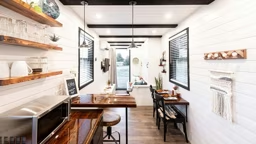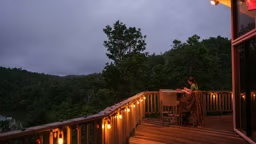
Design for Your Cabin Lifestyle
Whether your retreat is a waterside cabin, a desert hacienda or a ski lodge, time spent there is precious. To make the most of your stay, the layout needs to work for your family. Architects have the ability to tailor a cabin to the client’s lifestyle and the site. Accomplishing it takes a lot of know-how, input from the client, and dozens of big and small decisions along the way. Many folks, though, are sketchy on what architects do besides draw blueprints. Or, more to the point, how an architect can add value to your cabin.
Architecture “is a mystery profession,” acknowledges renowned Tampa architect Bud Dietrich, AIA. Dietrich’s designs have been featured in “Not So Big Remodeling” by Sarah Susanka and Marc Vassallo, and in other publications. “We as a culture know what to expect from a doctor, lawyer, accountant, but not from an architect. Homeowners tend to think architects cost money. It’s an expense, yes. But I’m convinced they can save you money by looking at your options and preventing mistakes.”
Often, architects can coax clients into a smaller footprint, says Good. Not only does reducing square footage save on building costs, it conserves energy. And foregoing a formal dining room or third bedroom (maybe occasional guests can sleep on a trundle bed or window seat) might free up dollars for a wood-burning fireplace, quality range, or maintenance-free deck.
“[Architects are] good at getting the most function out of less space,” says Albertsson. “If you think you need a 1,600-square-foot cabin, but your budget only allows for 1,400, or if you have a very tight space and you want it to do a long list of things, not everything needs its own room.”
Architects are up on the latest tricks to keep a cabin cozy, pleasant and energy-efficient. For example, does your place have a musty odor when you open it each spring? An architect may call for spraying closed-cell insulation into the wall cavities of an older cabin to stop drafts and prevent moisture and mold buildup. And energy-recovery ventilators keep just enough fresh air circulating when the cabin is not occupied, says Good. (An oversized bathroom ceiling fan set on a timer to go off for 10 minutes twice a day also works, he adds.)
What Does an Architect Do?
Architects offer a smorgasbord of services, from site analysis to interior design. “There isn’t one catchall way to do architecture,” notes Maine architect Russ Tyson. “It can be tailored to a client’s resources. We can do as much as they would like.”
The book “How to Work with an Architect,” by Gerald Morosco, AIA, is an excellent resource. Morosco identifies six steps or phases usually involved in a project:
- Programming or pre-design: Deciding what to build and setting a budget
- Schematic design: Initial designs that may include site drawings, elevations and 3D images
- Design development: Refining the schematics
- Construction documents: Essentially, nitty-gritty assembly instructions for your builder*
- Bidding or negotiating: Choosing the contractor
- Construction administration: Overseeing the actual building
After an architect has determined your needs and the site conditions, he or she is in a position to estimate what the home will cost. Factored in are the size of the cabin, the features, energy performance, and craftsmanship. An architect’s fees can range from 5–15% of construction costs. Fees at the higher end include more involvement during construction, including selecting fixtures and interior design.
Construction documents require the most work from an architect, and represent 40% of the fee. On a tight budget? “A very good builder may be able to take a limited set of drawings and build from them,” says Tyson. “But it has to be the right builder,” he emphasizes.
Be an Empowered Client
An architect will ask lots of questions about your intended use of the cabin: Is it just for summer, or year-round? Will you entertain frequent guests or host family reunions? Do you plan to retire there? Will it be passed down for future generations? Be prepared.
For the initial meeting, gather lots of pictures similar to what you hope to achieve with your project. Hopefully, you’ll find inspiration in the pages of your favorite magazines, like Cabin Life. These days, it’s easy to email your architect images you find in magazines or on the Internet. Social media sites like Houzz (www.houzz.com) can help homeowners find a handle on the design they want, and the right person to deliver it, says Dietrich.
“A lot of our clients are using Houzz,” agrees Albertsson. Her firm also uses Pinterest (www.pinterest.com). “It’s more person-to-person. Instead of sending people links, we will create a pin board for them.”
After listening to your expectations, hopes and desires, an architect is likely to come up with creative design ideas you would never have dreamed of on your own.
Future-Proof Retreats
A cabin must be rugged enough to withstand anything Mother Nature throws its way. For example, Florida retreats face wind-driven rain with objects hurled about like missiles, says Tampa architect Bud Dietrich. And, of course, California has earthquake issues. A licensed architect is legally responsible to make sure your cabin complies with building codes for safety.
An architect can also help design for unforeseen future catastrophes, says architect Nathan Good of Portland, Ore. These days, more clients are asking for “future-proof” retreats to withstand extreme weather like tornadoes, tsunamis, drought, windstorms and wildfires. Shown in the photo to the right is an insulated concrete form that is energy-efficient (R-25) and fire-, rot- and termite-proof.
Sense of Place
So that generic plan you found? Build it, and you may lose what attracted you to the site in the first place. “We see it too often, where somebody’s picked a plan and forced the site to meet the restraints of the cabin design,” says Russ Tyson, AIA, of Whitten Architects in Maine. Second homes in “Vacationland” make up 80% of Whitten’s business, with clients from as far away as California and Europe.
The firm, in Portland, Maine, is renowned for “site-specific” design – essentially, tailoring a cabin’s design plan to what exists on the site. “Amenities, views, orientation to the sun … it might be as simple as incorporating a beautiful tree or a rock outcrop,” says Tyson. An architect familiar with your area – along with local regulations, code and planning officials, and builders and materials – can ensure the best “fit” for your cabin.
Tweaking a floor plan on your own is also risky. For example, architect Nathan Good AIA, IIDA, LEED AP, witnessed a sad situation in Colorado. A couple building a passive-solar cabin flip-flopped the plan designed for south-facing windows. “They rotated it to face the pond to the west,” recalls Good, whose Portland, Ore., firm is noted for green design. “The afternoon sun was so harsh, with so much reflectivity from the water, it defeated the whole idea of looking out onto the pond at sunset.”
“We think a lot about the relationship between our appreciation of nature and how architecture can diminish or enhance that. One thing that doesn’t get talked about is the intangible benefit – how beautiful architecture can frame a place because of how you’re brought through the cabin,” says Christine L. Albertsson, AIA, CID, NCARB, a partner at Albertsson Hansen Architecture in Minneapolis, Minn.
Do I need an architect to design my new cabin or my cabin renovation? That’s a question Cabin Life hears a lot from readers. And it’s a fair question because certainly not everyone wants or needs the services of an architect.
The answer to the question depends on whether you fall into group A or B:
- GROUP A (the exception): Could be you’ve found the perfect design for your dream cabin. Your property is flat. Or your remodeling project is small and doesn’t involve load-bearing walls.
- GROUP B (the rule): Many cabins heed the “Call of the Wild.” Instead of a tight suburban lot, cabin-worthy sites typically have a topography that makes building a challenge. Often, the locale is environmentally sensitive and subject to a maze of building restrictions. Most likely, you fall into this category like the rest of us.
Waterside Cabins
Glare is just one issue when building or remodeling near the shoreline. Many other factors can hinder progress, and an architect can steer you clear of those, even hidden ones.
Safety, of course, is a priority. Is your area flood-prone? Architects have an arsenal of diversionary tactics that may not occur to city dwellers. Consider elevating the cabin on piers, says Good. He also recommends permeable surfaces such as gravel driveways, dry wells (underground structures with one or more entry pipes and numerous exit holes) to manage stormwater, and strategies to capture rainwater before it causes erosion.
Local wildlife is another consideration. A thoughtful remodel of an old Florida beach bungalow by Andy Dohmen, AIA, NCARB, of Design Styles Architecture in Clearwater, Fla., features a hurricane-resistant and turtle-friendly sliding glass door that admits light and views. (Impact-resistant “turtle glass” reduces the amount of artificial light projected from windows, so baby sea turtles hatched in sandy nests will scuttle towards the moonlit ocean, not up to the bungalow.)
Are setbacks involved for your project? Albertsson Hansen Architecture is frequently consulted about cabins that don’t conform to current codes. “Sometimes an old 1920s stick-built cottage, that’s practically falling down, has a great deal of value because it’s 30 feet from the lake,” says Christine Albertsson. One such occasion involved lifting a cabin to rebuild the foundation below the frost line, and reconfiguring the floor plan. The cabin was not enlarged, but a canopy was added at the front and a dormer at the back, along with a double-sided fireplace. By closing a portion of a wraparound screened porch, the living space was expanded and the lake view was enhanced.
Whitten Architects routinely walk clients through the process of “grandfathering” a camp within Maine’s 100-foot setback. “Typically, you can’t move closer to the water,” explains Tyson. “But you can add 30% in volume as long as it’s away from the water. We can show a town planning board all the documentation and what the camp will look like in 3D.”
The Acronyms
Only a licensed architect can use the title “architect.” In most states, a candidate must complete a minimum of 5 years of schooling and 3 years of working in an architect’s office before taking the licensing exams. Architects are required to renew their license, usually every 2 years. What’s with all those letters after an architect’s name? Here are some clarifications:
- AIA – Member of American Institute of Architecture
- CID – Certified Interior Decorator
- IIDA – Member of International Interior Design Association.
- LEED AP – LEED Accredited Professional (LEED stands for Leadership in Energy and Environmental Design – a rating system of the U.S. Green Building Council)
- NCARB – Registered with the National Council of Architectural Registration Boards and licensed to practice architecture in at least one U.S. jurisdiction, and may qualify for reciprocal registration in all states.
DESIGN RESOURCES
- Whitten Architects, www.whittenarchitects.com
- Nathan Good Architects, PC, www.nathangoodarchitect.com
- Albertsson Hansen Architecture, Ltd., www.aharchitecture.com
- Design Styles Architecture, www.designstylesarchitecture.com
- Harold Forrest “Bud” Dietrich, Architect, www.hfdarchitects.com










